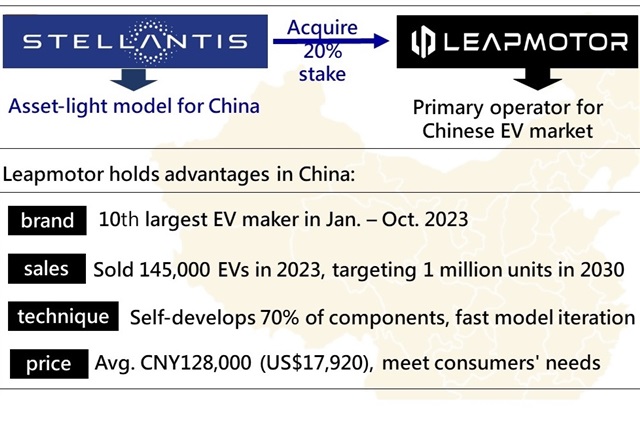International carmakers have been exploring ways to secure their market share in China, where EVs see robust growth. Jessie Lin, senior analyst with DIGITIMES Research, said the strategic partnership Stellantis built with Leapmotor last year was comprehensive. If the model works, it may enable more collaboration between traditional foreign automakers and emerging Chinese car companies.
In October 2023, Europe-headquartered Stellantis announced that it plans to invest EUR1.5 billion (US$1.635 billion) to acquire approximately 20% of China-based Leapmotor. The pair also said they will form the Leapmotor International joint venture to scale the Chinese EV company's global business.
Lin said Stellantis deepening ties with Leapmotor showed that the European automaker recognizes the EV expertise of Chinese companies. The partnership also reflected that Stellantis plans to utilize the advantages of Chinese EV makers to compete in and outside China.

Source: DIGITIMES Research
According to Stellantis' Dare Forward 2030 electrification targets, the company aims to sell 5 million EVs worldwide by 2030. It plans to take an asset-light business model in China to reduce costs and geopolitical risks.
Stellantis targets EUR20 billion in China's revenues by 2030, accounting for 6.7% of its overall goal, EUR300 billion.
Lin said cost competitiveness is a primary reason why Stellantis invested in Leapmotor. Stellantis has said Chinese companies see the factory price of their EVs as 30% lower than that of international carmakers. The costs of China-made EVs would still be 10% lower, even counting delivery charges, insurance fees, and anti-subsidy tariffs.
Stellantis recruited Leapmotor to become the former's 15th brand. Lin said Stellantis turned a rival into a leverage point with the acquisition. In addition, the European carmaker chose to work with an emerging company rather than a traditional automaker to limit the transaction price.
Lin said if Stellantis spent EUR1.5 billion on purchasing production facilities, it probably could only get a small one. With the same amount of investment, the automaker can now leverage Leapmotor to gain profits in China. Moreover, Stellantis' 51% share in the duo's joint venture means it can control most of the new company. Simultaneously, Leapmotor can use the fund to scale quickly.
According to Lin, Leapmotor has developed about 70% of its components, including power systems, battery modules, and autonomous driving technology. She also said the car maker's monthly sales volume has surpassed 10,000 units, reaching the break-even point. These indicators also made Leapmotor a suitable partner for Stellantis as it transitions to EVs, Lin added.
About the analyst
Jessie Lin received a master's degree from the Department of Business Administration at the National Taiwan University of Science and Technology. Her research focuses on automotive, LED, and display panels.

Credit: DIGITIMES



